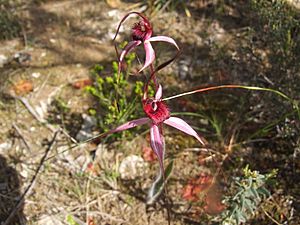Crucifix spider orchid facts for kids
Quick facts for kids Crucifix spider orchid |
|
|---|---|
 |
|
| Scientific classification | |
| Genus: |
Caladenia
|
| Species: |
cruciformis
|
| Synonyms | |
|
Arachnorchis cruciformis (D.L.Jones) D.L.Jones and M.A.Clem. |
|
The Crucifix spider orchid, also called the red cross spider orchid, is a special plant. It belongs to the orchid family. This orchid is very rare and only grows in a small part of Victoria, Australia. It's a ground orchid, meaning it grows in the soil. It has one slightly hairy leaf and a single flower that is dark red or crimson, often with black tips.
Contents
What Does the Crucifix Spider Orchid Look Like?
The Crucifix spider orchid is a perennial plant, which means it lives for more than two years. It's also a deciduous herb, losing its leaves each year. Underground, it has a small, round tuber (like a tiny potato).
In late autumn, a single leaf grows. It's about 8 to 10 centimeters (3 to 4 inches) long and 3.5 to 6 millimeters (0.1 to 0.2 inches) wide. The leaf has a few hairs and a reddish color at its base.
The orchid usually grows one flower on a thin, hairy stem. This stem can be 15 to 25 centimeters (6 to 10 inches) tall. The flower is dark red or crimson, sometimes pink, with darker red stripes. It even has a smell that some people say is like a hot motor!
Flower Parts
The flower has parts that look like arms and legs, which is why it's called a "spider orchid."
- The petals and lateral sepals (side parts) are 2.5 to 4 centimeters (1 to 1.6 inches) long. They spread out wide, making the flower look like a cross or a spider.
- The dorsal sepal (top part) stands straight up. It's about 1.5 to 2 millimeters (0.06 to 0.08 inches) wide at the bottom. It then narrows into a thin, thread-like end with a club-shaped tip. This tip is covered in tiny dark red glands.
- The lateral sepals also narrow into thread-like ends with club-shaped tips. These tips are shorter than the one on the dorsal sepal.
- The petals are shorter than the sepals and don't have the blackish tips.
- The labellum (the orchid's special lip) is egg-shaped and curves downwards. It's 10 to 14 millimeters (0.4 to 0.6 inches) long and 6 to 8 millimeters (0.2 to 0.3 inches) wide. It's dark red with a whitish base, and its sides turn upwards.
The labellum has a fringe of small teeth along its edges. In the middle, there are four to six rows of special bumps called calli. These calli look like tiny feet.
The Crucifix spider orchid flowers between September and October. After flowering, it forms a capsule that releases thousands of tiny black seeds.
How the Orchid Got Its Name
The scientific name for this orchid is Caladenia cruciformis. It was first officially described in 1999 by a botanist named David L. Jones. He found a sample of the plant near a place called Stuart Mill.
The name cruciformis comes from two Latin words: crux, which means "cross," and -formis, which means "shaped." So, cruciformis means "cross-shaped," which perfectly describes how the flower looks!
Where Does the Crucifix Spider Orchid Live?
The red cross spider orchid likes to grow in eucalypt forests or woodlands. It prefers areas with a lot of small, heath-like plants underneath the trees. It grows in sandy soil that has a lot of fallen leaves mixed in.
This orchid is only found in a very small area. You can find it near Stuart Mill and in the Dalyenong Nature Conservation Reserve in Victoria, Australia.
Why is This Orchid Important to Protect?
The Caladenia cruciformis is listed as "Endangered" by the Victorian Government. This means it's at high risk of disappearing forever.
Good news! There's been a successful project to grow more of these orchids and plant them back into nature. Young plants from this program have even started making their own seeds in new locations.
However, there are still some things that threaten this special orchid:
- People collecting firewood without permission.
- Animals, both native and introduced, eating the plants.
- Weeds growing and taking over the orchid's space.
- Fires that are not managed properly.
- People illegally collecting the orchids.
Protecting this unique plant helps keep our natural world healthy and diverse.

